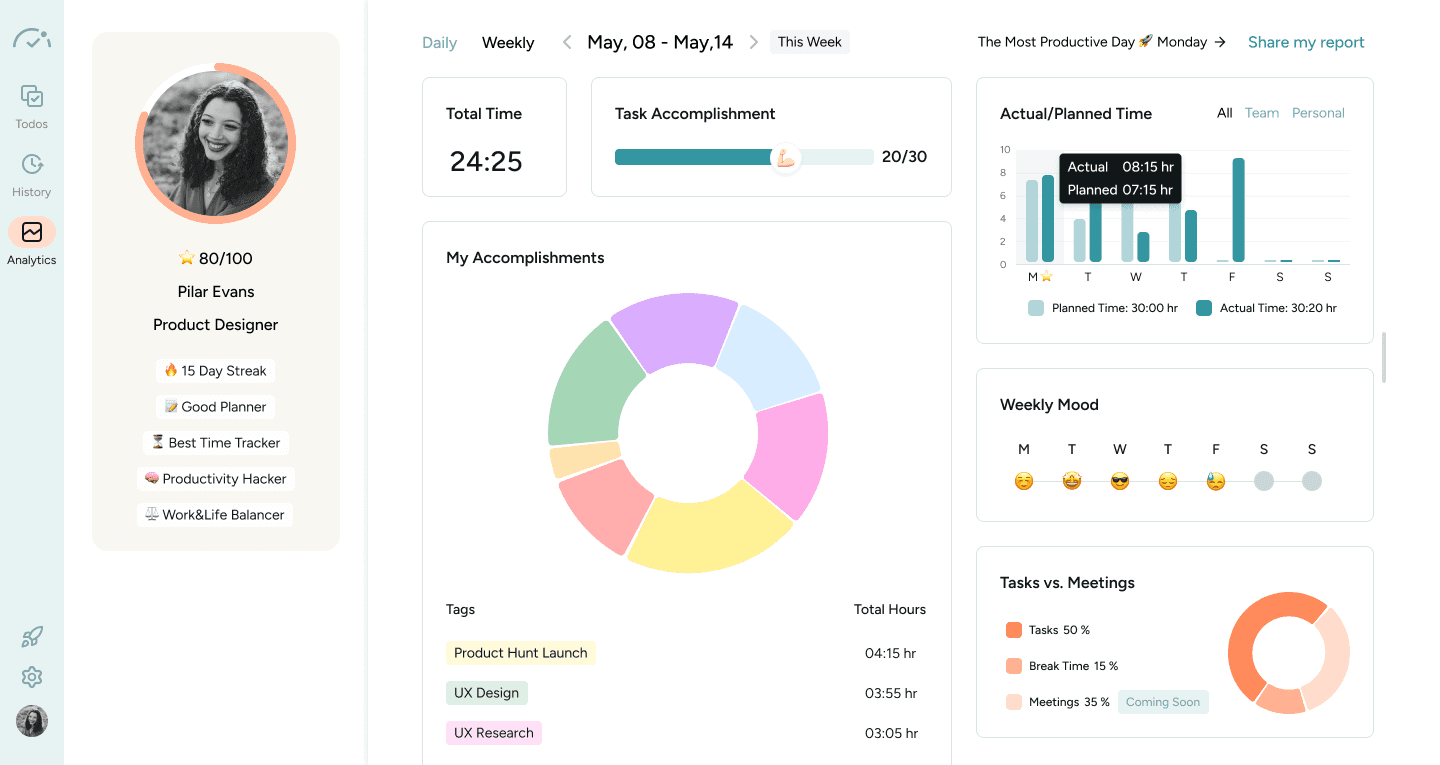In our journey through life, we often encounter endeavors that seem monumental, ambitions that appear insurmountable, and dreams that feel larger than life itself. These are what we commonly refer to as "big things." But have you ever stopped to wonder how these big things actually get done? What lies beneath the surface of these grand accomplishments? Join me as exploring the intricacies of achieving big things and unravel the process behind them.
You may also like:
Get It Done: How to Get Things Done From the Palm of Your Hand
Mastering Productivity: A Comprehensive Guide to Getting Things Done
Defining "Big Things"
Let's start by defining our terms. When we talk about "big things," we're referring to those significant accomplishments or endeavors that demand substantial resources, effort, and impact.
These could range from large-scale projects like building infrastructure or launching space missions to implementing transformative changes within organizations or society at large. The big things are the milestones that push boundaries, challenge norms, and leave a lasting mark on the world.
Understanding the Process of Getting Big Things Done
Why is it essential to understand how big things get done? Simply put, it's because knowledge is power. By unraveling the process behind achieving big goals, we gain valuable insights into the complexities and challenges involved.
This understanding allows us to better prepare, make informed decisions, and navigate the inevitable obstacles that arise along the way. Whether you're embarking on a personal passion project or spearheading a major initiative within your organization, grasping the process is key to success.
Key Components of Getting Big Things Done Method
So, what are the key components of the process? Here's a brief overview:
1. Planning: Setting clear objectives, identifying resources, establishing timelines, and crafting a strategic framework lay the groundwork for success.
2. Collaboration: Building the right team, fostering effective communication, and encouraging collaboration and innovation are essential for harnessing collective efforts.
3. Execution: Breaking down tasks, delegating responsibilities, monitoring progress, and adapting to changes form the backbone of execution.
4. Leadership: Providing vision and direction, empowering team members, making informed decisions, and taking responsibility for outcomes are vital aspects of leadership.
5. Resource Management: Budgeting, allocating resources effectively, optimizing time and energy, and leveraging technology and tools ensure efficient resource utilization.
6. Evaluation and Reflection: Assessing success criteria, gathering feedback, learning from mistakes and successes, and iterating and improving processes facilitate continuous improvement.
By understanding and effectively managing these components, individuals, teams, and organizations can navigate the journey toward achieving significant goals with greater clarity, confidence, and resilience.
The process of achieving big things is multifaceted and dynamic, requiring careful planning, collaboration, execution, leadership, resource management, evaluation, and reflection.
So, the next time you find yourself faced with a seemingly insurmountable challenge, remember that with the right approach and mindset, anything is possible. After all, that's how big things get done.
Planning Stage
Before embarking on any significant endeavor, it's crucial to lay a solid foundation through effective planning. The planning stage serves as the roadmap for navigating the journey towards achieving big things. Let's delve into the key components of this stage:
Setting Clear Objectives
Setting clear and well-defined objectives is the cornerstone of successful planning. Objectives serve as the guiding light, providing clarity on what needs to be accomplished and why it matters.
When setting objectives for big things, it's essential to ensure they are SMART: Specific, Measurable, Achievable, Relevant, and Time-bound.
This helps in aligning efforts, tracking progress, and staying focused amidst challenges.
Identifying Resources
Once objectives are established, the next step is to identify and mobilize the necessary resources to support the endeavor.
Resources may include financial capital, human capital, technology, infrastructure, and expertise.
Conducting a thorough resource assessment enables stakeholders to determine what is available, what is needed, and how resources can be optimized to maximize impact.
Establishing Timelines and Milestones
With objectives set and resources in place, it's essential to establish realistic timelines and milestones to track progress and ensure accountability.
Breaking down the journey into manageable stages with clear milestones helps in maintaining momentum, measuring success, and identifying potential bottlenecks or delays.
Timelines and milestones provide a framework for managing expectations and adjusting strategies as needed throughout the process.
Forming a Strategic Framework
Forming a strategic framework involves developing a comprehensive plan that outlines the overarching strategy, tactics, and action steps required to achieve the established objectives.
This framework serves as a blueprint for decision-making and resource allocation throughout the journey. It includes considerations such as risk management, stakeholder engagement, contingency planning, and alignment with broader organizational or societal goals.
In essence, the planning stage sets the stage for success by laying out a clear roadmap, mobilizing resources, establishing timelines and milestones, and forming a strategic framework to guide decision-making and action.
By investing time and effort into effective planning, individuals, teams, and organizations can enhance their likelihood of achieving big things and making a meaningful impact.

The Importance of Collaboration and Teamwork in Getting Things Done
Collaboration and teamwork are integral components of achieving big things, as they harness the collective strengths and expertise of individuals towards a common goal. Let's explore the key aspects of fostering effective collaboration and teamwork:
Building the Right Team: Building the right team is paramount to the success of any endeavor. This involves assembling individuals with diverse skills, experiences, and perspectives that complement each other and align with the objectives of the project.
When selecting team members, it's essential to consider factors such as expertise, motivation, cultural fit, and capacity for collaboration. A cohesive and well-balanced team lays the foundation for synergy and innovation.Effective Communication Channels: Effective communication is the lifeline of collaboration, ensuring that information flows seamlessly among team members, stakeholders, and relevant parties.
Establishing clear communication channels, both formal and informal, promotes transparency, reduces misunderstandings, and fosters trust within the team. This includes regular team meetings, progress updates, status reports, and feedback mechanisms to keep everyone informed and engaged throughout the project lifecycle.Encouraging Collaboration and Innovation: Creating a culture that values collaboration and innovation is essential for unleashing the full potential of the team. Encouraging open dialogue, brainstorming sessions, and cross-functional collaboration fosters creativity, generates new ideas, and promotes out-of-the-box thinking.
Providing opportunities for experimentation, risk-taking, and learning from failure cultivates a culture of innovation where team members feel empowered to contribute their unique insights and perspectives.Resolving Conflicts and Challenges: Conflicts and challenges are inevitable in any collaborative endeavor, but how they are managed can make or break the success of the project.
Establishing mechanisms for conflict resolution, such as mediation, negotiation, or escalation procedures, enables team members to address issues constructively and maintain focus on the common goal. It's essential to foster a supportive environment where team members feel comfortable expressing concerns, seeking assistance, and working together to overcome obstacles.
In essence, effective collaboration and teamwork are important for achieving big things, as they harness the collective strengths and expertise of individuals towards a common goal. By building the right team, establishing effective communication channels, encouraging collaboration and innovation, and resolving conflicts and challenges, individuals, teams, and organizations can maximize their potential and drive meaningful impact.
Evaluation and Reflection to Get Big Things Done
Evaluation and reflection are critical stages in the process of achieving big things. They provide opportunities to assess progress, gather insights, and iterate on strategies for continuous improvement. Let's delve into the key components of evaluation and reflection:
Assessing Success Criteria: Before evaluating the outcome of a project, it's essential to establish clear success criteria aligned with the initial objectives. Success criteria should be specific, measurable, achievable, relevant, and time-bound (SMART), allowing for an objective assessment of progress and achievement.
By comparing actual results against predefined success criteria, stakeholders can determine whether the project has met its intended goals and objectives.Gathering Feedback: Gathering feedback from stakeholders, team members, and relevant parties is essential for gaining diverse perspectives and insights into the project's performance.
This feedback can be collected through surveys, interviews, focus groups, or informal discussions, depending on the nature and scope of the project. Analyzing feedback helps identify strengths, weaknesses, opportunities, and threats, enabling stakeholders to make informed decisions and adjustments moving forward.Learning from Mistakes and Successes: Reflection on both mistakes and successes is crucial for fostering a culture of continuous learning and improvement. By analyzing what went well and what didn't, teams can identify patterns, trends, and lessons learned that can inform future endeavors.
Celebrating successes reinforces positive behaviors and achievements, while acknowledging mistakes encourages accountability and growth. Embracing a growth mindset allows individuals and teams to view setbacks as opportunities for learning and development.
D. Iterating and Improving Processes: Based on the insights gathered through evaluation and reflection, it's essential to iterate and improve processes to enhance future performance. This may involve refining strategies, adjusting plans, reallocating resources, or implementing new tools and technologies to address identified gaps and capitalize on opportunities.
By embracing a cycle of continuous improvement, organizations can adapt to changing circumstances, stay ahead of the curve, and drive sustainable success over time.
To sum up this section, evaluation and reflection are vital stages in the process of achieving big things, providing opportunities to assess progress, gather insights, and iterate on strategies for continuous improvement. By assessing success criteria, gathering feedback, learning from mistakes and successes, and iterating and improving processes, individuals, teams, and organizations can enhance their performance and drive meaningful impact in pursuit of their goals.
Get Big Things Done with BeforeSunset AI
BeforeSunset AI stands out as a comprehensive platform designed to streamline the daily planning and execution process for busy professionals. By harnessing the power of artificial intelligence, BeforeSunset AI empowers users to efficiently manage their time, tasks, and priorities, ultimately leading to increased productivity and satisfaction.
BeforeSunset AI offers a range of features tailored to individual and team needs, including AI-driven scheduling, task management, time tracking, and analytics. With its intuitive interface and seamless integration with Google Calendar, BeforeSunset AI simplifies the planning process, allowing users to create personalized schedules that align with their goals and preferences.
Moreover, BeforeSunset AI goes beyond mere task management by fostering a culture of collaboration and well-being within teams. With features like the team feed and member detail, team members can stay connected and informed about each other's projects and tasks without constant interruptions.
Additionally, the analytics tool provides valuable insights into team performance, enabling managers to make data-driven decisions for optimizing workflows and promoting a healthier work environment.
In a world where time is a precious commodity, BeforeSunset AI emerges as a valuable ally, helping individuals and teams make the most of every moment. Whether you're striving to achieve personal goals or drive collective success within your team, BeforeSunset AI equips you with the tools and insights needed to navigate the complexities of modern-day productivity.
So why settle for a scattered approach to planning when you can embrace the efficiency and clarity offered by BeforeSunset AI? Join us on this journey towards greater productivity, collaboration, and well-being.

